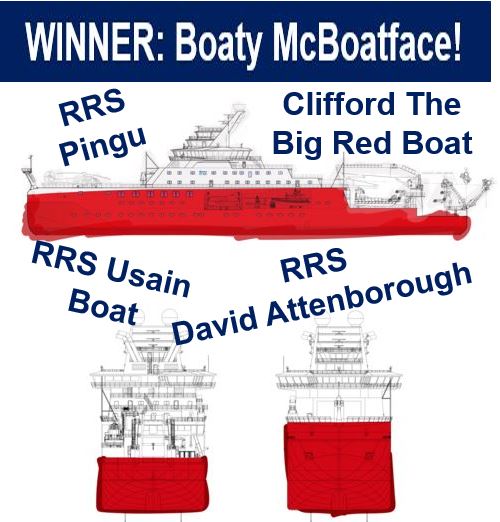Boaty McBoatface, an unmanned mini-sub, so named after a public vote, goes on its first Antarctic mission. Boaty McBoatface had been the name – by popular vote – for the UK’s new polar ship. However, Science Minister Jo Johnson was not keen on christening the new £200 million ship Boaty McBoatface, and named it after famous naturalist and broadcaster Sir David Attenborough. However, as a gesture to the hundreds of thousands of voters, the AUV (autonomous underwater vehicle) got the McBoatface name.
Boaty McBoatface will investigate water flow and turbulence deep down in the Orkney Passage, a 2.17 mile (2.5 km) deep region of the Southern Ocean.
Boaty McBoatface departs on March 17th
The minisub is to travel with the Dynamic of the Orkney Passage Outflow (DynOPO) expedition on the James Clark Ross, a BAS (British Antarctic Survey) ship. The crew, ship, minisub and other equipment will depart from Punta Arenas, a port-city near the tip of Chile’s southernmost Patagonia region, on 17th March.
 According to the National Oceanography Centre: “NOC’s Autosub Long Range (Boaty McBoatface) is joining ocean scientists from the University of Southampton and British Antarctic Survey (BAS) on an expedition to study some of the deepest and coldest abyssal ocean waters on earth – known as Antarctic Bottom Water (AABW) – and how they affect climate change.” (Image: noc.ac.uk)
According to the National Oceanography Centre: “NOC’s Autosub Long Range (Boaty McBoatface) is joining ocean scientists from the University of Southampton and British Antarctic Survey (BAS) on an expedition to study some of the deepest and coldest abyssal ocean waters on earth – known as Antarctic Bottom Water (AABW) – and how they affect climate change.” (Image: noc.ac.uk)
Boaty McBoatface will travel through the cold abyssal current that forms a key part of the worldwide circulation of ocean water.
The Telegraph, a British broadsheet newspaper, quoted Alberto Naviera Garabato, from the University of Southampton, who is leading the team, as saying:
“The Orkney Passage is a key choke-point to the flow of abyssal waters in which we expect the mechanism linking changing winds to abyssal water warming to operate.”
“We will measure how fast the streams flow, how turbulent they are, and how they respond to changes in winds over the Southern Ocean.”
“Our goal is to learn enough about these convoluted processes to represent them in the models that scientists use to predict how our climate will evolve over the 21st century and beyond.”
 One of the dangers of asking members of the general public to think up and then vote for a new name for a boat, is that you never know what you might end up with. Boaty McBoatface won the vote after stiff competition from Clifford the Big Red Boat, RRS Usain Boat, and RRS Pingu. (Image: adapted from Name Our Ship campaign)
One of the dangers of asking members of the general public to think up and then vote for a new name for a boat, is that you never know what you might end up with. Boaty McBoatface won the vote after stiff competition from Clifford the Big Red Boat, RRS Usain Boat, and RRS Pingu. (Image: adapted from Name Our Ship campaign)
Dr Povl Abrahamsen, co-researcher and BAS oceanographer, added:
“The DynOPO project will provide us with a unique, high-resolution dataset combining moored and moving instruments, which will help us get to the bottom of the complex physical processes occurring in this important region.”
Head of Marine Autonomous and Robotic Systems at National Oceanography Centre, Dr Maaten Furlong, explained:
“We have a long history of developing and operating autonomous underwater vehicles in support of UK science with our first science campaigns in the late 1990s. More recently we have been pioneering the development and use of long range underwater and unmanned surface vehicles.”
“The deployment of Autosub Long Range in the Antarctic expands our robotic vehicle capability and places us at the forefront of AUV development.”
Video – Boaty McBoatface
In this NERC Science video, published last year, Linto Roberts, Managing Director of Cammel Laird Shipyard, talked about the impact on jobs, skills and the shipbuilding industry in the UK following the new NERC research vessel – the one that nearly ended up being called Boaty McBoatface. The video formed part of the Name our Ship campaign.
